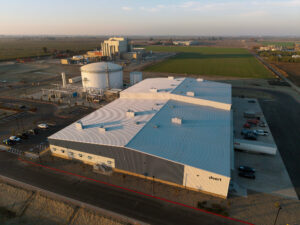April 8, 2024
In this article: What is the EPA Wasted Food Scale? | Research behind the Wasted Food Scale | Interpreting the Wasted Food Scale | Climate impacts vs resource scarcity | Nuances of the Middle Pathways | Key Takeaways from the EPA’s Wasted Food Scale | Conclusion
Summary: The EPA’s New Wasted Food Scale assesses and ranks different wasted food pathways based on environmental impact and circularity. An analysis by Divert reveals that Anaerobic Digestion is the strongest performing pathway after Prevention and Feeding Others, making it an ideal diversion tactic for scaling wasted food reduction at commercial and industrial levels. Furthermore, Divert’s facilities deploy almost all of the EPA’s preferred pathways.
What is the EPA Wasted Food Scale?
In October 2023, the EPA updated its important-but-outdated Food Recovery Hierarchy with a new model: the Wasted Food Scale. The scale is a high-level assessment of wasted food pathways, intended to help wasted food generators make informed choices about diversion. It contrasts most and least preferred pathways based on environmental impact and circularity theme performance.
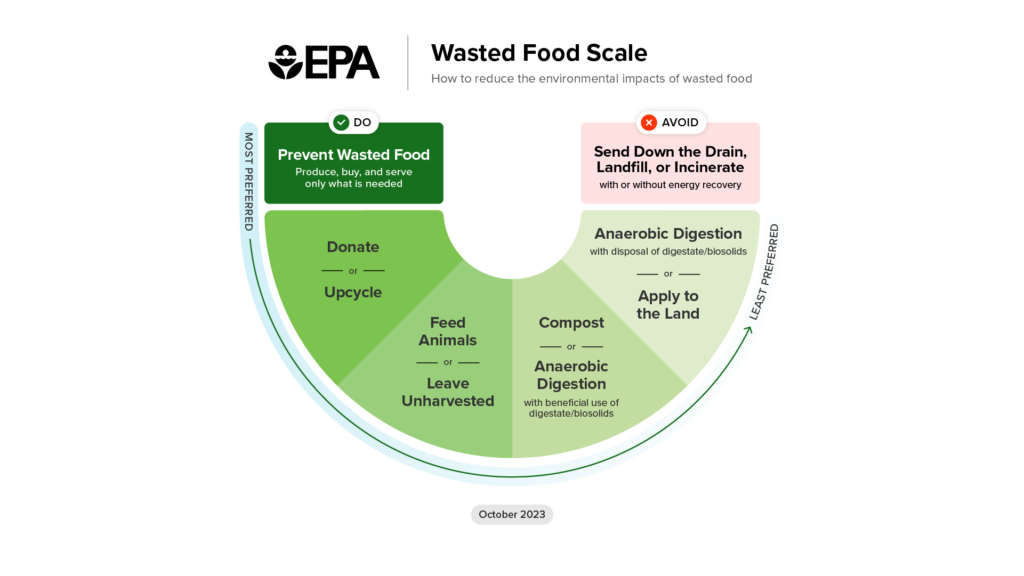
What is the research behind the Wasted Food Scale?
The EPA’s assessment of wasted food pathways is informed by:
- A quantitative analysis of methane emissions from landfilled food waste
- A quantitative life cycle analysis (LCA) of the environmental impact of alternative wasted food pathways (~250 studies over 3 decades)
- A qualitative circularity assessment, which relies on circularity themes that are not, as of yet, well studied
While the quantitative analysis on landfill emissions and the LCA allow us to measure with certainty the environmental impact of each wasted food reduction pathway, similar methods for evaluating the circularity of each pathway are part of a newer discipline that is still in a nascent stage and not yet well studied.
How should the Wasted Food Scale be interpreted?
Anyone using the EPA Wasted Food Scale to evaluate their diversion options should ask themselves two questions:
- Should I look for a solution that prioritizes climate impacts, resource scarcity, or both?
- How should I interpret the nuances between the EPA’s “middle pathways”?
We’ll explore both of these questions in detail below.
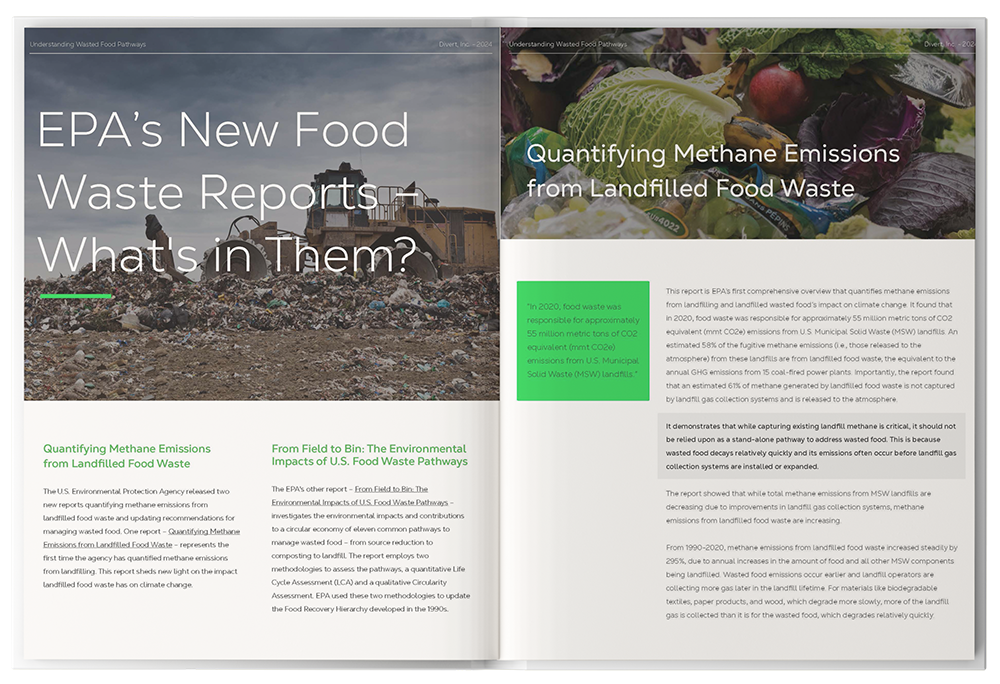
Learn More:
Get a full analysis of the EPA’s Wasted Food Scale in our free whitepaper. Learn to make informed choices about waste diversion now!
1. Should I look for a solution that prioritizes climate impacts, resource scarcity, or both?
It’s important to keep in mind that the EPA considers climate impacts as well as resource scarcity in its evaluation of pathways to create a combined score on the scale. For “climate impacts”, the EPA looks at the environmental impacts of how the wasted food is recovered, as well as whether there are any beneficial outputs with a positive climate impact. For “resource scarcity”, the EPA looks at whether the pathway captures value from existing materials, or is restorative or regenerative in design. While both are important factors to consider, the urgent and existential threat of climate change means that prioritization should favor food reduction pathways that produce the most beneficial outcomes for the climate.
2. How should I interpret the nuances between the EPA’s “middle pathways”?
While the EPA reports that the differences in environmental performance between the middle-performing pathways are small, that is not to say that these four options are more-or-less interchangeable.
When prioritizing the middle pathways, two important factors must be considered:
- Individual circumstances may affect prioritization
- A pathway’s position in the scale isn’t necessarily static
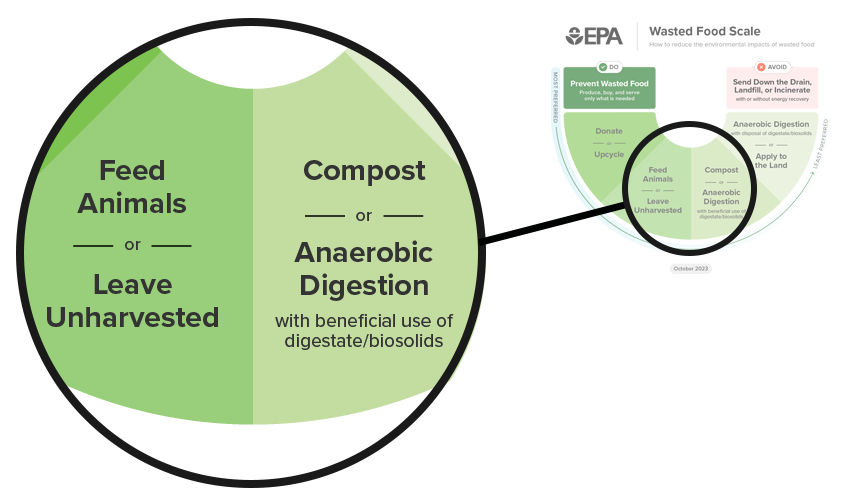
1. Individual circumstances that can affect prioritization
Individual circumstances may impact how each wasted food reduction pathway should be prioritized. These include:
- Homogeneity, contamination, packaging and moisture content
- Stage of the food supply chain at which food is wasted
- Availability of local infrastructure and end-markets for recycled materials made from wasted food (e.g., soil amendments or energy)
- Local policies or requirements for recycling wasted food and local priorities such as air and water quality.
2. Why a pathway’s position in the scale should not be considered static
The EPA report notes that some pathways may deploy certain elements that would change their position on the scale. For example, Divert’s most often chosen pathway, Anaerobic Digestion, is ranked similarly to Composting in the overall scale. However, it’s noted as more beneficial than Composting in nearly every environmental impact considered in the Life Cycle Assessment.
Additionally, “Stand-alone” Anaerobic Digestion (i.e. digesting separated food waste without green (yard) waste, manure, or human wastewater) is equal-to or preferred-to Composting in the Circularity Assessment as long as its digestate byproduct is added to compost for beneficial land application.

The nuances of the middle pathways reinforce the strength of solutions like Divert’s
The nuances of the EPA’s middle pathways reinforce the business model and design Divert selected when it initiated its investment in new Integrated Diversion & Energy Facilities to scale wasted food reduction across the U.S. These facilities not only incorporate the EPA’s most preferred pathways (source reduction and donation), but also Stand-alone Anaerobic Digestion.
The EPA’s report makes it clear that Stand-alone Anaerobic Digestion is the best approach to scale wasted food reduction at a commercial and industrial level because it scores high on purity and contamination reduction while focusing solely on nutrient-dense wasted food without incorporating green (yard) waste, human wastewater, or animal manure into its process.
Key takeaways from the EPA Wasted Food Scale
Key takeaway #1: Divert facilities deploy almost all of the EPA’s “most preferred” pathways.
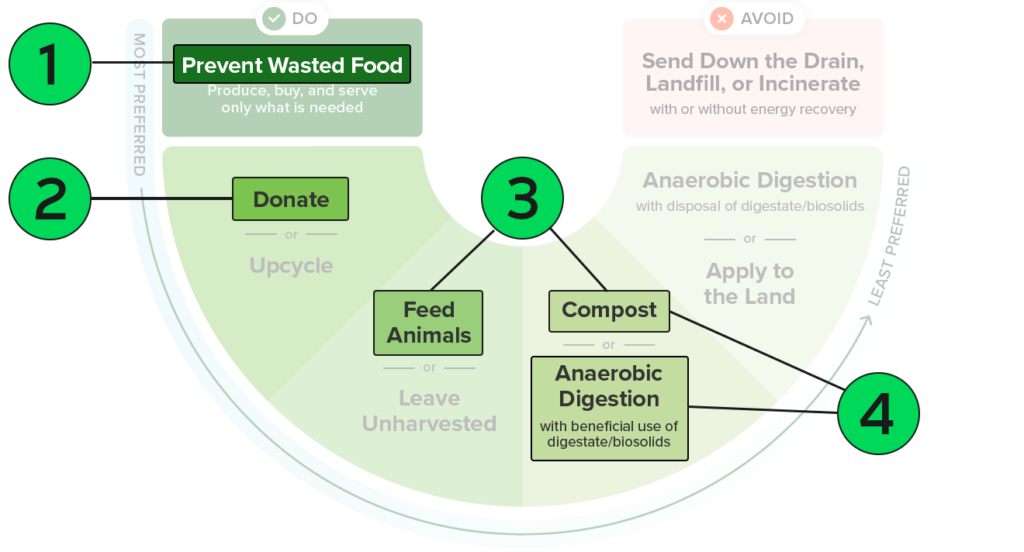
- Providing actionable data and insights to enable source reduction and prevent wasted food.
- Deploying actionable insight and technology to improve customer donation efforts, including facilitating donations directly at our Food Recovery Center.
- At certain facilities, sending wasted food to animal feed and compost.
- At our new Integrated Diversion & Energy Facilities, producing:
(a) Renewable energy through Anaerobic Digestion, a process with more beneficial environmental impacts than Composting.
(b) Digestate that is reintroduced back into the agricultural supply chain as a soil amendment for composting, fulfilling critical circularity goals and addressing resource scarcity.
Key takeaway #2: the EPA’s Life Cycle Assessment shows that after Prevention and Feeding Others, Anaerobic Digestion is the strongest performing pathway.

Global Warming Potential (GWP)
For Anaerobic Digestion systems like Divert’s, the benefits of the process (capture of biogas to offset fossil fuels, avoided fertilizer manufacture and use, avoided methane emissions from landfill diversion) far exceed any negligible GWP impacts of the process itself. For Anaerobic Digestion systems like Divert’s, the benefits also outperform composting.

Energy Demand
After source reduction, donation and animal feed, Anaerobic Digestion systems like Divert’s have the greatest potential for negative energy demand. In contrast, composting has a net positive energy demand. This is based on the EPA’s Energy Demand Indicator, which weighs:
- The pathway’s energy use
- Energy generation offset
- Avoided energy use from food production, animal feed production or fertilizer production

Other Environmental Impacts
Anaerobic Digestion systems like Divert’s outperformed composting and other pathways across a variety of other indicators:
- Acidification (impact on terrestrial environment)
- Particulate matter formation
- Eutrophication (nutrient impact on water)
- Water consumption
- Human toxicity
- Ecotoxicity
Key takeaway #3: the EPA’s Circularity Assessment shows that after Prevention and Feeding Others Stand-Alone Anaerobic Digestion is strongest performing circularity pathway.
The primary goal of circularity is to reduce the consumption of natural resources and materials, and minimize waste. In its scoring of Stand-Alone Anaerobic Digestion, the EPA looked at the process across the following circularity themes:
- Waste Prevention: Stand-alone Anaerobic Digestion offers alternative beneficial uses for waste material.
- Value: Stand-alone Anaerobic Digestion recovers nutrients from wasted food, as well as energy to replace fossil fuels.
- Purity: Anaerobic Digestion prevents physical plastic, metal, glass, and other contaminants from re-entering the agricultural stream. Composting is unable to prevent this contamination without deploying complex separating equipment. In addition, Stand-alone Anaerobic Digestion ranks higher than Composting within this Circularity Theme, because it does not incorporate human wastewater, animal manure, or green (yard) waste. This is in contrast to digesters that accept wasted food along with a variety of sources such as manure, or wastewater, or green (yard) waste.
- Regeneration: The digestate from stand-alone Anaerobic Digestion is reintroduced back into the food supply chain.
In addition to this Stand-Alone Anaerobic Digestion capability, Divert’s new Integrated Diversion & Energy Facilities also support Wasted Food Prevention through Source Reduction and Food Donation. This unique approach ensures that wasted food reduction optimizes Life Cycle Assessment environmental impact and Circularity Assessment outcomes.
Note: In its analysis, the EPA also notes that circularity does not guarantee beneficial environmental results, since recovering materials can require additional water, energy or transportation. It recommends that evaluating the Circularity Assessment and Life Cycle Assessment together can capture important externalities that can inform conclusions.
Conclusion
Divert applauds the EPA’s focus on wasted food and its impacts on the environment and climate. The updated Wasted Food Scale and two supporting reports from the EPA provide increased visibility to the issue of wasted food at a critical time for our environment.
While the synthesized scale is a good general summary of where each pathway stands relative to one another across each methodology, the report is also clear that more nuanced wasted food reduction pathways should be prioritized when evaluating the most preferred pathway for a particular use.

